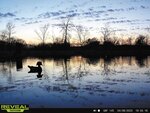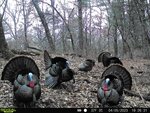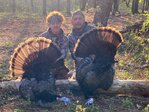




Many folks here in Monroe County are gearing up for the upcoming hunting and fishing seasons, here in Wisconsin. While the hunters, fishermen and fisherwomen are doling out dollars for proper camouflage clothing and blinds, rods and reels, licenses and permits, and hooks and bullets, the seasons themselves are doling out dopamine drops by the dozens to enthusiastic sportsmen and women.
An estimated 895,000 people hunt in Wisconsin each year, with 553,479 licenses being issued for gun-deer hunting, in 2023 alone. When you broach the figures for fishing in Wisconsin, the numbers are a staggering 1.4 million, or 1 in 3 of all Wisconsin residents, according to the fisheries staff, at Wisconsin.gov
Spotlight on a Local Professional
Pat Howard was born and raised in Monroe County, specifically in Sparta. Howard resides in Onalaska now, but his parents, Harley and Betty Howard, own acreage in Little Falls, so he still has access to the wonderment and beauty of Monroe County.
To say that Howard is an avid hunter would be a gross understatement of his talents and expertise. Sportsman more accurately depicts his love, not only for the thrill of the hunt and fishing alone, but his enjoyment of the environment; his gratitude for the land; and his optimism for opportunities in digitally capturing the magical world of Monroe County wildlife.
One of the areas that Howard has become proficient in over the years, is the trail camera. Howard’s strong promotion of Reveal’s Tactacam prompted the company to call him up 2 and a half years ago and say, “You do so much promoting for us, and we have not been paying you, so you might as well come and work for us — so he did.
The Camera Calendar, According to Howard
Pat Howard presented an unsolicited breakdown of the calendar year, as it pertains to the cameras in conjunction with the hunting seasons and neutral zones, or breaks between hunting. The mere fact that Howard casually commented on the camera calendar is a testament to how hunting, wildlife, and all aspects of nature are a matter-of-fact conversation piece for Howard.
“When we are checking the cameras in January, we are looking to see what bucks have survived the [hunting] seasons. For January going into February and March, we are checking for antler sheds of the bucks.” When pressed by the Herald on the significance of knowing when the antlers are shed by the bucks, Howard’s laughing response was, “So we can go look for them.”
Howard continued into the camera calendar with March, April, and May. “These months are about turkeys, geese, swans, and cranes,” he stated. “As heavy as I am into hunting and fishing, I have developed a passion for remote photography, especially with swans, cranes, and eagles. This passion helps to fill the gaps between hunting seasons. Because of my obsession with waterfowl photos, my peers have given me the nickname ‘Aqua man.’ The truth is that I want to spend as much time in the woods as I can, and this photography venture allows me to meet my being-outdoors quota.”
Howard then stated that in May, the fawns start to drop, and that it is really fun to see the new guests walking in the forest. For the next few months, June, July, and August, Howard informed the Herald that it is a time to watch the fawns grow. As well, the bucks are now growing out their antlers. “I am anxious to check the cameras during these seasons as well,” Howard said. “Because now you see the yearly growth and improvement of the bucks lurking around in your neck of the woods. The antlers are covered in velvet, and that is a special gift to witness from nature. We see the continuing of that gift, through the photos of the bucks rubbing off the velvet, through buck rubs on trees.”
Howard says that because September and October are hunting months, cameras are concentrated on food plots and acorn trees, as well as waterholes. “This is where we channel our inner Sherlock Holmes and start piecing patterns together, so that we may figure out when and where we can position ourselves to get that big buck.”
Howard informed the Herald that the digital photos provide an accurate log, as to where the game was, at what time, and even what the weather was like. “On the cell camera app (Reveal), you can save the bucks to a gallery, click on weather statistics and it tells you where the wind was blowing, and if it is a NW wind, where the buck is most likely to be. It breaks it all down, really good.” In the Google Play App, in can be found as Tactacam REVEAL.
No Ice Fishing Equals Major Bummer for Howard
Howard had lived for a while out of the state of Wisconsin, nearly four years, between Kentucky and Iowa, but moved back to appease his healthy appetite for ice fishing. With the oddness and quick fluctuations of temperature this year, Howard said that there were actually only three days where it was safe to ice fish. “This year [for ice fishing] has been disappointing,” Howard stated, in a lower toned and dismal voice. “My favorite thing to do is ice fish. We had one week of frigid temperatures that lead to only three days of solid ice; then we were right back to 50 degrees and rain.”
To add company to the misery, the three days of ice-fishable ice were a Monday through Wednesday time period — days that Howard had to work.
A Million a Month
When pressed by the Herald on how many cameras he keeps track of, Howard responded with around 350. “My boss and I keep track of all these cameras, on four separate land parcels. In a month, I am going through nearly a million photos. To say that out loud makes me realize how insane that is.”
Howard says that he looks at most of these photos on his phone, and a majority of the rest on his tablet. He says that mostly the photos are used for tracking and keeping tabs on animals that are on the land, as well as their habits and travel patterns. “We also do a calendar each year. It is tough to choose the twelve best photos. I pick 100 photos, and then whittle them down to 12 … it is not easy.”
History and Advancements
With all the advancement in AI technology, cell phones, and digital communication, the Herald asked Howard what advancements the trail cams have made, from when he personally first started using them, up to present day. “The very first one [trail camera] I had was actually a film camera. If you were a rookie, like I was, you would get 26 photos of a leaf blowing back and forth. You would hustle to the One Hour photo and get those 26 photos developed, and as you thumbed through them, they were of the same leaf, going back and forth.”
Howard went on to explain that where we are today almost seems like fiction. “It is impressive that now you can just pick up your phone and the photos are right there.”
Howard then spoke to his advancement, as a photographer with trail cameras, and what his curiosity has brought to him. “I started in 2008, wondering what dear were roaming around my hunting areas. Then I thought, ‘I wonder what else is around here?’ So, I positioned a camera on a log that was crossing a creek.”
Indeed, when the photos started rolling in from the camera focused on the log, there were many different animals utilizing nature’s makeshift bridge, to get safely across the frigid, fast-moving waters of the creek. “I wanted to see the different critters that were using the log. We saw bobcats, turkeys, coyotes, deer, racoons, possums, squirrels, fishers, and even a bear.”
Setting Up the Shot
With years of trail camera experience comes a curiosity for creativity. For Howard, the shots became not only about the creature that would be caught in time, but about the background scenery, shuffling the snapshot from a point of record to art. “For me, it has turned into what I like to call remote photography,” Howard explained. “Because now I want a picture of a wood duck, but I also want the sunset in the background, or a building, such as an old barn or a home, for the backdrop.”
Gun Hunting, Meh
Howard says that he is not too fond of gun season, but many hunters do it out of tradition. For Howard, it all has to do with the timing of the rut. “The best time [of the year] to hunt is the last five days of October and the first ten days of November … that is where it’s at really. That falls into bow hunting territory.”
Topping the list of reasons why Howard likes this specific timeframe is not only looking for and bagging the big buck, but it encompasses what you hear and see that makes it a magical moment in the cosmos. “On a good day you will see 5 bucks chasing the same doe, or you will see the bucks fighting,” Howard started to explain. “You get to hear the bucks grunt and roar. If you have never heard a buck roar, it is something you need to do before you die. The noises these animals make is otherworldly.”
In describing the roar of the buck, Howard says that it is like a deep growl. “And the little bucks don’t growl. So, when you hear that roar, you are like ‘Come over here big fella!’”
Truth in the Buck Rub
One common myth, according to Howard, is the bigger the tree for a buck rub, the bigger the buck. “Rather than look at the size of the tree, you should look at the height of the rub. The higher it is, the bigger the buck.”
Then Howard remarked on an interesting point. “Oddly enough, I have found a few rubs in the past few years, and I put a camera on them. I was very surprised to see how many different bucks will rub the same tree, marking it, like a scent post. ‘This is my post!’ and the next buck says, ‘No, it is mine!’ These snubs at each other’s claim on the rub is not too dissimilar from dogs peeing on tires and fire hydrants.”
Turkey Hunting Love
The Herald interview shifted to turkeys, and Howard’s eyes lit up like a Christmas tree. “If you made me choose between the rut and Spring turkey hunting, I don’t think I could do it. The chance to hunt something that you can call to, and it talks back to you … it is on another level. You can hear them getting closer and closer and closer, and then they are right in front of you.”
Howard hunts with a Remington 870 12 gauge. “I like them inside of 40 yards, but I’ve seen guys shoot them at 60 and 70 yards. I like to get them close.”
Howard says that when he is out West, and he is on a huge track of land, he likes to walk and call, until he gets one to answer. “Then I will set up on him. On a smaller plot of land, we find that it is better to just sit tight and let them do their thing.”
Howard said that there are many opportunities to buy a tag, and that they are only $10 a tag, until they are gone. He also informed the Herald that when they shoot a turkey, they eat it that day. “We never put them in a Freezer. We clean ‘em, kabob ‘em, and put them right on the grill that night.”
Turkey Score
The biggest turkey Pat ever shot was 26 pounds. “To score a turkey, you measure the beard. If it has more than one beard, you measure all of them. You measure the spurs and the weight, and you get a total score. The National Wild Turkey Federation (NWTF) has the official scoring system on their website.”
One time he shot one with two beards, while his significant other, Jennifer, shot one with three beards. “That’s $1,000 trip to the taxidermist,” he quipped.
Clothing
With four seasons in Monroe County, the Herald pressed Howard on the different types of clothing needed. “You want something that will hold your scent in,” he started out. “Because we live in Wisconsin, you need to have early season, mid-season, and late season clothing. We go from light weight, in the warmer months, to kind of warm for the Fall, and then super warm, for the biting winter temperatures.”
Howard paused for a second, and claimed, “Clothing can get expensive.”
Howard finished up by telling the Herald, “Turkeys cannot smell, so you can get away with a bit more with them over dear. Their eyesight is killer though. You don’t get away with much with the turkeys. A blind really helps out with them. That way you can play Yahtzee on your phone, or whatever, to pass the time, until the action starts.”
The Herald would like to thank Pat Howard for his time and photo contributions to this feature story.
Comments
No comments on this item Please log in to comment by clicking here